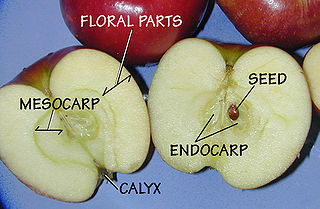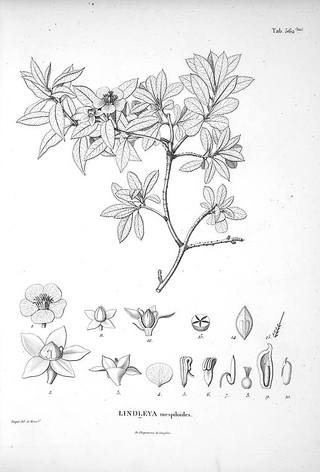
Rosaceae, the rose family, is a medium-sized family of flowering plants that includes 4,828 known species in 91 genera.

Amygdaloideae is a subfamily within the flowering plant family Rosaceae. It was formerly considered by some authors to be separate from Rosaceae, and the family names Prunaceae and Amygdalaceae have been used. Reanalysis from 2007 has shown that the previous definition of subfamily Spiraeoideae was paraphyletic. To solve this problem, a larger subfamily was defined that includes the former Amygdaloideae, Spiraeoideae, and Maloideae. This subfamily, however, is to be called Amygdaloideae rather than Spiraeoideae under the International Code of Nomenclature for algae, fungi, and plants as updated in 2011.

The subfamily Spiraeoideae was traditionally a subfamily of flowering plants within the family Rosaceae. The taxonomy of this subfamily has changed several times in the last century as more detailed studies have been carried out. Spiraeoideae as defined before 2007 is paraphyletic, leading some authors to define a broader subfamily which includes the Spiraeoideae as well as the Maleae, and the Amygdaloideae. Such an expanded subfamily is to be called Amygdaloideae under the International Code of Nomenclature for algae, fungi, and plants.

The quince is the sole member of the genus Cydonia in the Malinae subtribe of the Rosaceae family. It is a deciduous tree that bears hard, aromatic bright golden-yellow pome fruit, similar in appearance to a pear. Ripe quince fruits are hard, tart, and astringent. They are eaten raw or processed into marmalade, jam, paste or alcoholic beverages.

In botany, a pome is a type of fruit produced by flowering plants in the subtribe Malinae of the family Rosaceae. Pome fruits consist of a central "core" containing multiple small seeds, which is enveloped by a tough membrane and surrounded by an edible layer of flesh. Pome fruit trees are deciduous, and undergo a dormant winter period that requires cold temperatures to break dormancy in spring. Well-known pomes include the apple, pear, and quince.

Sorbus is a genus of over 100 species of trees and shrubs in the rose family, Rosaceae. Species of Sorbus (s.l.) are commonly known as whitebeam, rowan, mountain-ash and service tree. The exact number of species is disputed depending on the circumscription of the genus, and also due to the number of apomictic microspecies, which some treat as distinct species, but others group in a smaller number of variable species. Recent treatments classify Sorbus in a narrower sense to include only the pinnate leaved species of subgenus Sorbus, raising several of the other subgenera to generic rank.

Photinia is a genus of about 30 species of small trees and large shrubs, but the taxonomy has recently varied greatly, with the genera Heteromeles, Stranvaesia and Aronia sometimes included in Photinia.

Chamaemespilus is a genus of shrubs in the family Rosaceae. It is monotypic, being represented by the single species Chamaemespilus alpina, commonly known as false medlar or dwarf whitebeam. It is native to the mountains of central and southern Europe, from the Pyrenees east through the Alps to the Carpathians and the Balkans, growing at elevations of up to 2500 m.

Stranvaesia is a genus of flowering plants in the family Rosaceae. Its morphology is so similar to Photinia that it has sometimes been included within that genus, but recent molecular data indicate that the two genera are not related.

Mespilus, commonly called medlar, is a monotypic genus of flowering plants in the family Rosaceae containing the single species Mespilus germanica of southwest Asia. It is also found in some countries in the Balkans, especially in Albanian and Bulgarian regions. A second proposed species, Mespilus canescens, discovered in North America in 1990, proved to be a hybrid between M. germanica and one or more species of hawthorn, and is properly known as ×Crataemespilus canescens.

Vauquelinia, commonly known as the rosewoods, is a genus of the rose family, Rosaceae. It consists of two species of shrubs found in the southwestern United States and northwestern Mexico. The genus was named for French chemist Louis Nicolas Vauquelin (1763-1829). The nectar provided by these plants is commonly fed on by wasps such as Polistes instabilis.

Gillenia is a genus of two species of perennial herbs in the family Rosaceae, Gillenia stipulata and Gillenia trifoliata. Common names for plants in this genus include: Bowman's root, Indian-physic, American ipecac. This genus is endemic to dry open woods with acidic soils in eastern North America. Both plants are subshrubs with exposed semi-woody branches and serrated leaves; the larger lower leaves are divided into palmately arranged leaflets. Plants bloom in May, June, or July; blooms are composed of five slender white petals which are loosely arranged and typically appear slightly twisted and limp as if they were wilted. The flowers mature into small capsules. G. stipulata and G. trifoliata are often planted as ornamentals and used in herbal medicine.

Kageneckia is a genus of flowering plant in family Rosaceae.

Lindleya is a genus of Mexican evergreen trees of the family Rosaceae, tribe Maleae. The sole species, Lindleya mespiloides, grows to a height of 6 metres (20 ft) and bears solitary white fragrant flowers in summer. The fruit are dry dehiscent capsules.
Stigmella oxyacanthella is a moth of the family Nepticulidae, found in Europe and North America. The larvae are leaf miners feeding inside the leaves of trees and shrubs, such as hawthorn, apple and pear.

The Maleae are the apple tribe in the rose family, Rosaceae. The group includes a number of plants bearing commercially important fruits, such as apples and pears, while others are cultivated as ornamentals. Older taxonomies separated some of this group as tribe Crataegeae, as the Cydonia group, or some genera were placed in family Quillajaceae.

Malinae is the name for the apple subtribe in the rose family, Rosaceae. This name is required by the International Code of Nomenclature for algae, fungi, and plants, which came into force in 2011 for any group at the subtribe rank that includes the genus Malus but not either of the genera Rosa or Amygdalus. The group includes a number of plants bearing commercially important fruits, such as apples and pears, while others are cultivated as ornamentals.

Torminalis is a genus of plants in the rose family Rosaceae. The genus Torminalis was formerly included within the genus Sorbus, as the section Torminaria, but the simple-leafed species traditionally classified in Sorbus are now considered to form a separate monophyletic group. It is monotypic, being represented by the single species, Torminalis glaberrima, commonly known as wild service tree, chequers, and checker tree. This tree is native to Europe, parts of northern Africa and western Asia.

Hedlundia is a genus of plants in the rose family. They are shrubs or small trees that have a hybrid origin involving crosses between Aria and Sorbus sensu stricto. There are about 48 species are distributed across central, western and southern Europe, Scandinavia, Turkey, the Caucasus, Crimea, and also central Asia. The term Hedlundia was published in 2017.


















